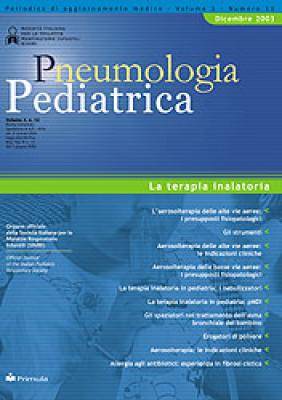Archivio > Vai alle uscite del 2003 > Vai aVolume 3, Numero 12 - Dicembre 2003
- La terapia inalatoria
Allergia agli antibiotici: esperienza in fibrosi cistica Antibiotic allergy: experience in cystic fibrosis patients

Riassunto. Nei pazienti con fibrosi cistica sono ormai numerose le segnalazioni di reazioni allergiche alla terapia antibiotica. Il meccanismo etiopatogenetico sembra essere uguale a quello che si verifica nella popolazione generale. Il motivo principale potrebbe essere l’eccessivo utilizzo di terapia antibiotica endovenosa. Queste reazioni allergiche sono basate su un meccanismo IgE mediato. Le manifestazioni cliniche vanno da: eruzioni maculo-papulari fino allo shock anafilattico. Ma, per motivi di antibiotico resistenza, in fibrosi cistica è necessario utilizzare spesso lo stesso antibiotico che ha causato la reazione allergica; in questo caso è una buona opzione eseguire la tecnica di desensibilizzazione prima della somministrazione del farmaco. Questo metodo consiste nella somministrazione di quantità crescenti di farmaco fino a che il paziente non riceve la dose terapeutica. In questo modo non abbiamo mai avuto reazioni allergiche gravi; solo una volta abbiamo sospeso per l’insorgenza di un rash orticariode severo. Ripetiamo questa tecnica ogni qualvolta un paziente allergico necessita il trattamento antibiotico.
Summary. A high incidence of allergic reactions to antibiotics has been reported in patients with cystic fibrosis (CF). The main reason this hypersensitivity develops could be the increased use of intravenous (i.v.) antibiotics. The etiopathogenetic mechanism of adverse reactions in CF is the same as that for the general population. The reactions are based on an IgE-mediated mechanism. The clinical manifestations range from maculo-papular eruptions to severe anaphylactic shock. Conversely, in CF, because of the limited sensitivity of the pathogens, it is sometimes necessary to use the same drug that caused the allergic reaction. In the case here reported, desensitization was a good option. This method involves administering extremely small quantities of the drug i.v. and increasing the dose approximately every 15 minutes until the patient receives a therapeutic dose. Subsequently, the patient receives his usual treatment. No severe reaction has ever occurred following this procedure, except for one case in which the treatment had to be interrupted. This kind of desensitisation needs to be repeated every time the patients require antibiotic treatment. Prior experience has shown that drug desensitization is a safe method and a powerful tool for treating allergic patients.






